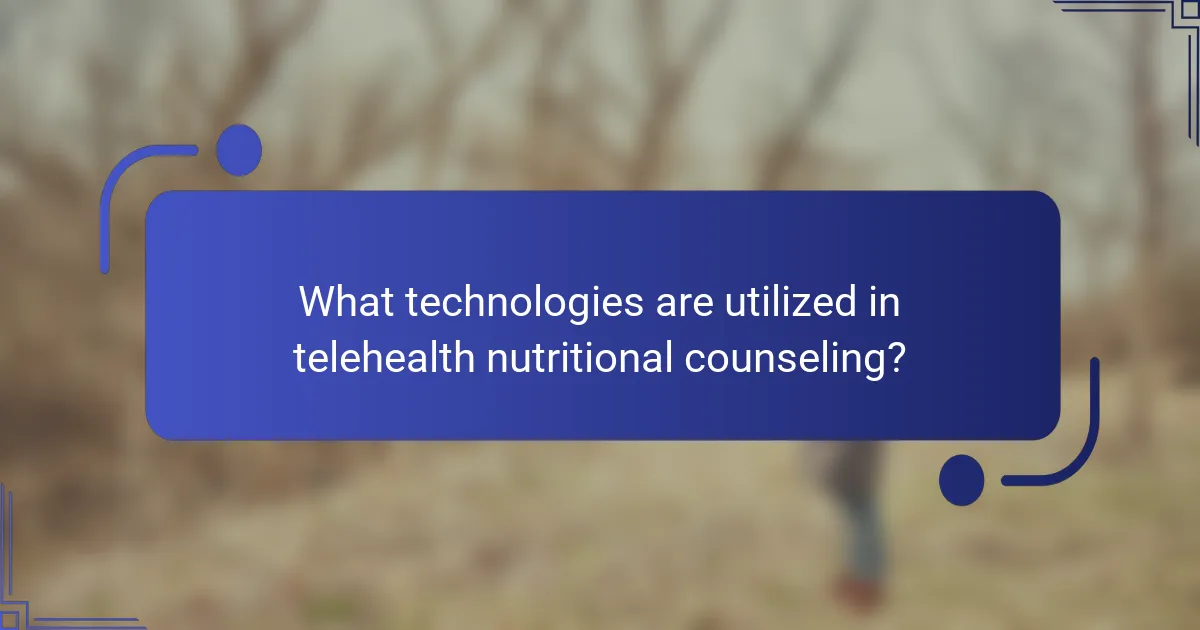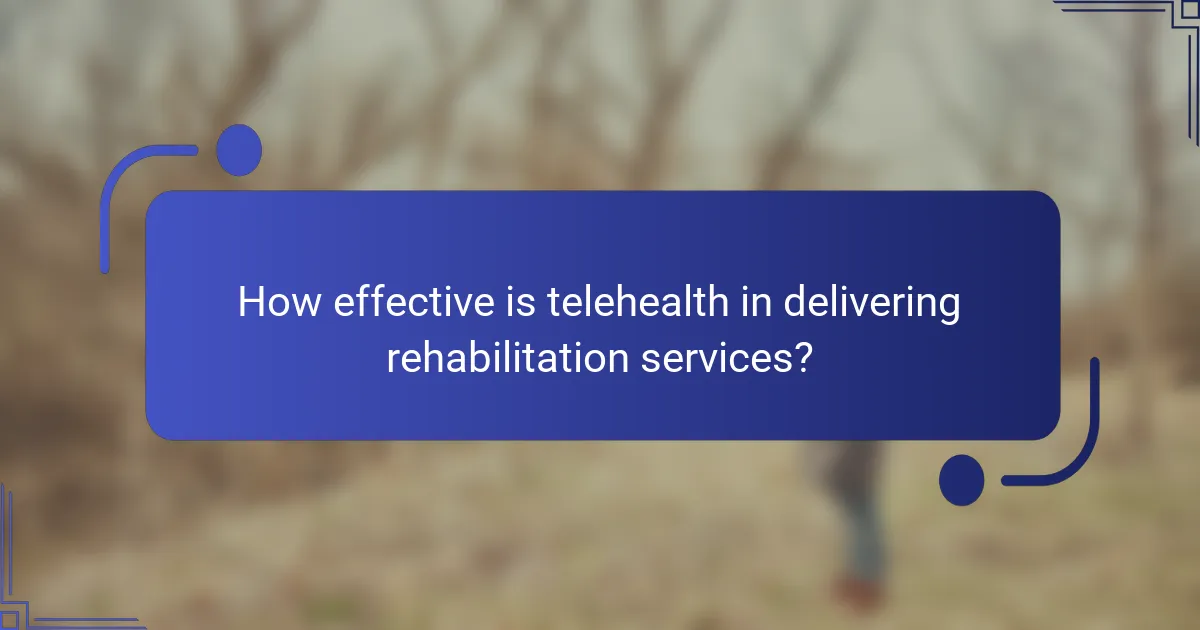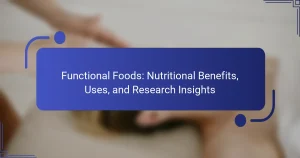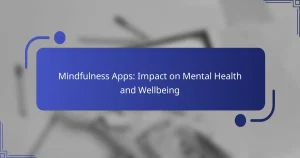Telehealth solutions improve access to nutritional counseling and rehabilitation by eliminating geographical barriers and offering flexible scheduling. Key technologies like video conferencing and mobile health applications enhance patient engagement and support tailored nutritional plans. Despite challenges such as technology access and data privacy, innovative features like AI-driven personalized nutrition plans and real-time biometric monitoring empower users in their health journey. Best practices for effective telehealth counseling include clear communication, personalized plans, and regular follow-up support.

How do telehealth solutions enhance access to nutritional counseling?
Telehealth solutions significantly enhance access to nutritional counseling by removing geographical barriers and providing flexible scheduling options. Patients can connect with registered dietitians from their homes, ensuring timely and convenient consultations. This approach increases engagement and adherence to nutritional plans, leading to better health outcomes. Additionally, telehealth platforms often incorporate user-friendly technology that facilitates communication and resource sharing, further enriching the counseling experience.
What are the key benefits of telehealth in nutritional counseling?
Telehealth in nutritional counseling offers enhanced accessibility, personalized support, and improved patient engagement. It allows clients to connect with nutritionists remotely, eliminating geographical barriers. This convenience leads to increased adherence to dietary plans and better health outcomes. Studies indicate that telehealth can reduce no-show rates by up to 30%, promoting consistent follow-up and accountability. Additionally, telehealth solutions often provide flexible scheduling, accommodating diverse lifestyles and preferences.
Which populations benefit the most from telehealth nutritional services?
Populations that benefit most from telehealth nutritional services include those with limited access to healthcare, chronic disease patients, and individuals in rural areas. These groups often face barriers to in-person consultations, making telehealth a vital resource. Telehealth improves access, allowing for personalized nutritional counseling and support. Additionally, it provides flexibility for busy individuals and those with mobility issues.
How does telehealth address barriers to traditional nutritional counseling?
Telehealth effectively removes barriers to traditional nutritional counseling by enhancing accessibility and convenience. It allows clients to receive guidance from registered dietitians remotely, reducing the need for travel and wait times.
Additionally, telehealth caters to individuals in underserved areas, where access to nutritional experts is limited. This mode of counseling can also accommodate diverse schedules, making it easier for clients to engage in their nutritional rehabilitation.
Moreover, telehealth platforms often incorporate user-friendly technology, which can enhance client engagement and adherence to nutritional plans. This integration of technology represents a unique attribute of telehealth solutions that traditional counseling may lack.
As a result, telehealth not only broadens access but also tailors nutritional counseling to fit individual needs and lifestyles, promoting better health outcomes.

What technologies are utilized in telehealth nutritional counseling?
Telehealth nutritional counseling utilizes various technologies to enhance accessibility and effectiveness. Key technologies include video conferencing platforms, mobile health applications, and electronic health records.
Video conferencing allows real-time interaction between clients and nutritionists, facilitating personalized consultations. Mobile health applications enable users to track dietary habits, receive reminders, and access educational resources. Electronic health records streamline information sharing, ensuring that nutritionists have comprehensive patient data for informed decision-making.
These technologies collectively improve patient engagement and support tailored nutritional plans.
Which platforms are most popular for telehealth nutritional services?
Telehealth nutritional services are most popular on platforms like Teladoc, Amwell, and HealthTap. These platforms provide convenient access to registered dietitians and nutritionists, enhancing patient engagement. Teladoc offers a user-friendly interface and a wide range of specialists. Amwell emphasizes personalized care plans, while HealthTap integrates AI for tailored nutrition advice. These platforms collectively improve accessibility and affordability in nutritional counseling.
How do mobile applications facilitate nutritional counseling through telehealth?
Mobile applications enhance nutritional counseling through telehealth by providing accessible platforms for real-time consultations and personalized meal planning. They facilitate communication between clients and nutritionists, enabling consistent support and tracking of dietary progress. Features such as video calls, chat functions, and integrated food diaries allow users to receive tailored advice and adjust their habits effectively. Additionally, mobile apps can incorporate unique attributes like personalized reminders and gamification elements to engage users and encourage adherence to nutritional goals.
What role do wearable devices play in telehealth nutrition monitoring?
Wearable devices significantly enhance telehealth nutrition monitoring by providing real-time data on dietary habits and physical activity. These devices track metrics such as caloric intake, nutrient levels, and exercise patterns, enabling personalized nutritional counseling. As a result, healthcare providers can offer tailored recommendations based on accurate, continuous data. This integration fosters better adherence to nutritional plans and improves overall health outcomes. Wearable technology also empowers patients by allowing them to engage actively in their health management, thus promoting a proactive approach to nutrition.

How effective is telehealth in delivering rehabilitation services?
Telehealth is highly effective in delivering rehabilitation services, improving access and convenience for patients. Studies indicate that telehealth can enhance patient engagement, reduce travel time, and provide timely interventions. A meta-analysis revealed that telehealth rehabilitation yields similar outcomes to in-person sessions, with 80% of patients reporting satisfaction. Additionally, unique attributes like personalized care plans and real-time monitoring contribute to its effectiveness, making it a valuable solution in rehabilitation settings.
What specific rehabilitation services can be offered through telehealth?
Telehealth can offer various rehabilitation services, including physical therapy, occupational therapy, speech therapy, and mental health counseling. These services improve access to care and enhance patient engagement.
Physical therapy sessions can be conducted via video calls, allowing therapists to guide patients through exercises. Occupational therapy focuses on improving daily living skills through virtual assessments and interventions. Speech therapy utilizes telehealth for articulation and language development exercises. Mental health counseling provides support through remote sessions, ensuring continuity of care.
Research indicates that telehealth rehabilitation can increase patient adherence to treatment plans by up to 30%. This modality also reduces travel time and costs, making rehabilitation more accessible for patients in remote areas.
Overall, telehealth enhances the delivery of rehabilitation services, ensuring patients receive timely and effective care.
How does telehealth compare to in-person rehabilitation for effectiveness?
Telehealth can be as effective as in-person rehabilitation, depending on the individual’s needs and circumstances. Studies show that telehealth solutions provide equal access to nutritional counseling and rehabilitation services, offering flexibility and convenience. Patients report high satisfaction rates with telehealth, which can lead to improved adherence to treatment plans. Unique attributes of telehealth include the ability to reach underserved populations and reduce travel-related barriers. In some cases, rare attributes like personalized virtual interactions enhance the effectiveness of therapy. Ultimately, both methods have their strengths, and the choice may depend on personal preference and specific health goals.

What unique challenges do telehealth solutions face in nutritional counseling?
Telehealth solutions in nutritional counseling face unique challenges such as technology access, patient engagement, and data privacy. Limited internet access in rural areas restricts participation. Additionally, some patients may struggle with technology, affecting their engagement. Ensuring data privacy and compliance with regulations adds complexity to telehealth services. These challenges can hinder the effectiveness of nutritional counseling and rehabilitation.
How do cultural differences impact the acceptance of telehealth solutions?
Cultural differences significantly influence the acceptance of telehealth solutions. Factors such as trust in technology, communication styles, and health beliefs shape user engagement.
In cultures with high uncertainty avoidance, individuals may prefer in-person consultations over virtual ones. Conversely, cultures valuing technology may embrace telehealth for its convenience and accessibility.
Language barriers can also impact the effectiveness of telehealth services. Tailoring solutions to local languages and cultural contexts enhances user comfort and satisfaction.
Moreover, cultural attitudes towards health and wellness can dictate the perceived legitimacy of telehealth. Understanding these differences is crucial for successful implementation and adoption of telehealth solutions in diverse populations.
Which regulatory hurdles affect telehealth nutritional counseling?
Regulatory hurdles affecting telehealth nutritional counseling include licensure requirements, reimbursement policies, and privacy regulations. These factors create barriers to providing consistent and accessible services across different states and platforms. Licensure varies by state, requiring practitioners to navigate complex legal frameworks. Reimbursement policies often limit coverage for telehealth services, impacting financial viability. Privacy regulations, such as HIPAA, necessitate strict compliance, adding operational challenges for providers. Addressing these hurdles is crucial for enhancing access to nutritional counseling through telehealth solutions.

What rare but impactful features do leading telehealth platforms offer?
Leading telehealth platforms offer rare features that significantly enhance user experience and outcomes. These include AI-driven personalized nutrition plans, real-time biometric monitoring, and advanced tele-rehabilitation tools.
AI-driven personalized nutrition plans adapt to individual health data, providing tailored dietary recommendations. Real-time biometric monitoring allows for continuous tracking of health metrics, ensuring timely interventions. Advanced tele-rehabilitation tools facilitate interactive recovery sessions, promoting engagement and accountability.
These features not only improve access to nutritional counseling and rehabilitation but also empower users to take control of their health journey.
How do personalized nutrition plans enhance telehealth services?
Personalized nutrition plans significantly enhance telehealth services by tailoring dietary recommendations to individual health needs. This customization improves patient engagement and adherence to nutritional guidance. Studies show that personalized approaches lead to better health outcomes, including weight management and chronic disease prevention. Telehealth platforms can leverage data analytics to create these plans, ensuring they align with patients’ lifestyles and preferences.
What innovative approaches are being tested in telehealth rehabilitation?
Telehealth rehabilitation is exploring innovative approaches like virtual reality, artificial intelligence, and remote monitoring devices. These methods enhance patient engagement, personalize treatment plans, and provide real-time feedback. For example, virtual reality can simulate real-world scenarios for rehabilitation exercises. Additionally, AI algorithms analyze patient data to optimize therapy sessions. Remote monitoring ensures adherence to rehabilitation protocols, improving outcomes. These advancements aim to make rehabilitation more accessible and effective, addressing the unique needs of patients.

What best practices should be followed for effective telehealth nutritional counseling?
For effective telehealth nutritional counseling, follow these best practices: establish clear communication, utilize technology efficiently, personalize dietary plans, maintain confidentiality, and ensure follow-up support. These practices enhance patient engagement and improve health outcomes.
1. Establish clear communication: Use simple language and confirm understanding.
2. Utilize technology efficiently: Ensure reliable platforms for video consultations.
3. Personalize dietary plans: Tailor recommendations based on individual health needs.
4. Maintain confidentiality: Adhere to privacy regulations and secure patient data.
5. Ensure follow-up support: Schedule regular check-ins to monitor progress.
How can practitioners ensure patient engagement in telehealth sessions?
Practitioners can ensure patient engagement in telehealth sessions by utilizing interactive tools and personalized communication strategies. Incorporating features like video conferencing, chat options, and educational resources enhances the experience. Regular follow-ups and feedback surveys can also foster ongoing participation. Creating a supportive environment encourages patients to voice concerns and ask questions, improving overall satisfaction and adherence to nutritional counseling and rehabilitation plans.
What common mistakes should be avoided in telehealth nutritional counseling?
Common mistakes in telehealth nutritional counseling include inadequate preparation, poor communication, and overlooking technology issues. These pitfalls can hinder effective counseling.
First, failing to prepare can result in missed opportunities for personalized advice. Counselors should gather comprehensive client information beforehand.
Second, ineffective communication can lead to misunderstandings. Clear and concise language is essential for conveying nutritional guidance.
Lastly, neglecting technology can disrupt sessions. Ensuring a stable internet connection and familiarizing oneself with the telehealth platform is crucial for smooth interactions.
What strategies enhance the effectiveness of telehealth in rehabilitation?
Telehealth in rehabilitation can be enhanced through strategies like personalized care plans, regular follow-ups, and integration of technology. These approaches improve patient engagement and adherence.
Utilizing video consultations allows for real-time feedback, fostering a supportive environment. As a result, patients feel more connected and motivated.
Incorporating data analytics helps track progress and tailor interventions, ensuring effective treatment. This personalized approach is crucial for achieving optimal rehabilitation outcomes.
Lastly, training healthcare providers in telehealth tools enhances communication skills, leading to better patient-provider relationships. This strategy is vital for successful telehealth implementation in rehabilitation.


